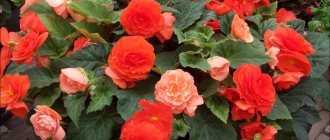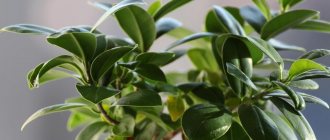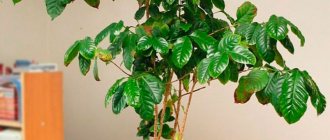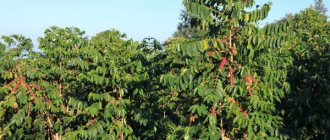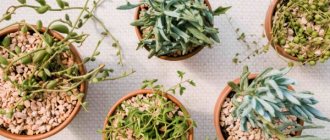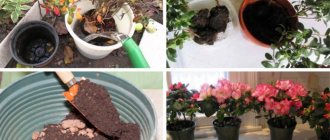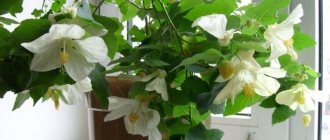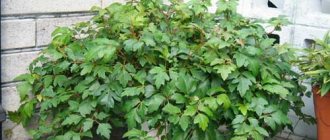Indoor trees are very popular in modern decorative floristry. Compared to regular flowers, they require significantly less care. At the same time, a small tree looks impressive in almost any room.
Dear readers! For you, we have created communities on social networks in which useful articles and interesting ideas are published several times a day! Subscribe and receive useful content in a convenient format!
In today's article we will talk about one of the most popular indoor woody plants, the coffee tree.
Botanical description and homeland of the plant
The plant is part of the Rubiaceae family. The tree's homeland is ancient Abyssinia (modern Ethiopia). Now the coffee tree can be found even in the wild in South America, Asia, and other areas of Africa.
Indoor varieties are widespread everywhere.
At home, coffee is a low bushy tree that grows mainly in several thin trunks. The plant does not branch much. The process of formation of additional shoots usually begins only in the 2nd year. Coffee has large oval leaves with a pointed tip. The surface of the leaf blade is slightly convex with clearly visible veins. The color is green.
Coffee blossoms and bears fruit. The inflorescence is umbellate and consists of small white flowers. After flowering, a fruit is formed, which turns red when ripe. The berry is covered with a small crust, inside there is sweet and sour pulp and a couple of seeds-grains, from which the famous drink is prepared.
Soil Features
Arabica coffee grows at home in slightly acidic soil. The soil is purchased in specialized stores or prepared independently. At home, mix a loose composition, which includes:
- river silt and sand;
- dry moss, peat and charcoal;
- a layer of earth with “leaf” humus.
Homemade soil is mixed in equal proportions and sterilized for several minutes in a water bath. The planting container is selected with a reserve for the future root system. There are perforated holes at the bottom of the pot for effective drainage of liquid.
Caring for your coffee tree after purchase
Before you go to the store and buy yourself a new green pet, you should think about where to put it. Remember that coffee is a tree, and although it will not grow to several meters at home, it still needs space.
So, you bought yourself a coffee seedling. First of all, he must be quarantined. This is necessary so that the plant gets used to the new conditions. Also during this time you can find out whether the plant is sick and whether pests live on it.
In addition to quarantine, the coffee tree can be replanted. A transplant is required in the following cases:
- Several coffee cuttings sit in one container;
- The pot is too low quality;
- The soil mixture is a nutrient substrate, not ordinary soil.
ON A NOTE. Don't worry if all the leaves have fallen off the tree after replanting. This is due to the fact that all the plants in stores are “overfed”. Very soon the coffee will return to normal.
Natural growing conditions for coffee trees
Ethiopia is originally considered to be the birthplace of coffee trees. The first trees of this species appeared there, from which all other varieties of Arabica originated. The Arabian variety is also called Arabica. Another interesting fact that confirms that the first trees appeared in Ethiopia is that any local resident can easily drink 12 cups of the strongest drink and still feel great after that amount of caffeine.
If a European, whose previous generations had no relation to the alkaloid and were not accustomed to it, drinks such an amount of coffee, he will definitely end up in the hospital with poisoning.
There is one difference: the Ethiopians used grains for food, and the Arabs learned to make a drink from them
There is also a Congolese tree or robusta. His homeland is also Africa, but this time Congo. This tree is more common because it has strong immunity to diseases and environmental conditions.
Growing conditions
In general, the coffee tree does not pose impossible tasks for the grower. The plant needs quite ordinary care and growing conditions, but with its own characteristics.
Temperature
Coffee loves warmth, but does not handle heat very well. The ideal temperature is 23 – 25 degrees. In winter, you can slightly reduce the temperature, but only to 15 degrees. If the temperature drops further, the coffee may shed its leaves.
IMPORTANT! Protect the tree from sudden changes in ambient temperature and drafts. Both have a negative effect on flowering and fruiting.
Air humidity
Coffee prefers high air humidity. In a dry climate, the tree does not feel well, often gets sick, and blooms poorly.
Additionally, it is recommended to spray the plant with a spray bottle. In the summer, you can periodically “bathe” the coffee tree.
IMPORTANT! In winter, the tree tub should be placed away from radiators, as the tips of the leaves will begin to wither due to dry air.
Coffee also loves fresh air, so we recommend periodic ventilation in winter. The main thing is to make sure that there is no draft, as this can make the plant sick.
Coffee tree after spraying
Lighting
The coffee tree comes from Africa, which means it loves light. But it is still undesirable to expose it to direct sunlight. It would be ideal to shade the plant a little. To do this, you can cover the windows with paper, use tulle or Roman blinds.
ON A NOTE. If your apartment does not have the right place with sufficient lighting, then the coffee tree can be placed under fluorescent lamps.
The soil
For a coffee tree, it is better to choose acidic soil (with a pH level less than 7). If you prepare the soil yourself, then follow these proportions: 2 parts acidic peat, 1 part distilled, 1 part sand, 1 part each leaf and greenhouse soil.
Pot
It is equally important to choose the right pot. In a container that is too small, the plant will be cramped. The roots will quickly fill the entire volume, and the coffee will begin to hurt. If it is too large, on the contrary, the tree will not be able to receive all the nutrients when watering and feeding.
It follows from this that you need to choose a medium-sized pot for the plant, so that it is not cramped, but there is space to grow.
In what cases is support needed?
Sometimes your green pet may need support. These are mainly cases when the plant has too thin shoots, as well as after transplanting into a new pot, when the tree has not yet taken root.
Choosing a place to put it
Indoors, the coffee tree is best placed near a south window. If this is not possible, then place the tree on the east or west window.
It is not recommended to place the pot in dark corners or in the back of the room. Lack of lighting negatively affects the decorative qualities of the plant.
In late spring and summer, the coffee tub can be moved to the loggia or taken out to the terrace. The tree will really like this, as it will be provided with a sufficient amount of light and fresh air.
What does it look like in the interior?
The coffee tree is not just another flower in a pot. This is part of the interior decor of any room. The plant looks beautiful in a modern studio apartment, office, and bedroom. The coffee tree is also great for decorating public spaces: cafes, reception areas, corridors, conservatories, etc.
How to start a coffee tree at home
The best option for your home is an Arabica coffee tree. Robusta, although less fastidious, requires cross-pollination, so it is more difficult to get it to bear fruit. If you don’t have enough space in your house, you can buy dwarf Arabica beans or sprouts, one of the most popular varieties is Albert.
There are 3 ways to get a coffee tree:
- sprout from a grain;
- grow a cutting;
- buy in the store.
Growing coffee trees from beans
Ordinary green coffee beans intended for making a drink are unsuitable for germination: they have been collected too long ago and, in addition, they are subjected to special processing.
Coffee beans harvested no more than 1–1.5 months ago have the best germination. Such seeds can be purchased in online stores.
But it is best to ask the owner of the coffee tree for a ripe berry. Nature itself has covered the coffee beans with juicy pulp, so there is no need to soak them.
The optimal temperature for seed germination is from +19 to +24 °C.
Soil composition for sowing:
- 1 part peat;
- 1 part sand;
- 2 parts of turf land.
- The soil mixture must be prepared 2 weeks before sowing.
- Sowing berries:
- the soil in the pot should be moist;
- The berry is placed on its side (flat side down) in a hole approximately 1 cm deep, sprinkled with earth, which is lightly pressed;
- The pot is covered with a jar and placed in a warm, bright place (but it should not be exposed to direct sunlight).
It will take a long time for the berries to germinate, about 3–6 months. But 2 sprouts can appear from the grains at once. They are kept under glass until the cotyledon leaves shed their hard shell. Periodically, condensation is wiped off the walls of the jar. When the cotyledon leaves expand, the plant gradually begins to adapt to the drier climate of the room.
Grains freed from pulp germinate somewhat faster (after 1–3 months).
Sowing the grain:
- The seeds are soaked for 30 minutes in a very weak solution of potassium permanganate, and then for another 30 minutes in aloe juice.
- The grains are planted in the same way as berries: in a hole 1 cm deep, flat side down.
- After planting, the soil is moistened abundantly and the pot is covered with a jar.
Coffee trees grown from beans bloom in the 3rd or 4th year.
Propagation of coffee trees by cuttings
To plant cuttings, prepare a substrate in advance from peat and sand, taken in a 1:1 ratio.
Planting a cutting:
- A branch with 2 pairs of leaves is cut 2.5–3 cm below the bud. The cut should be oblique, it is treated with “Kornevin” or another rooting stimulator.
- The cuttings are vertically stuck into well-moistened soil so that the lower buds are covered with substrate.
- The cutting is covered with a plastic bag in which a small hole is cut. Periodically through this hole the cuttings are sprayed with warm water.
A rooted cutting can be replanted only after a new pair of leaves appears. Coffee trees grown from cuttings bloom in the 2nd or 3rd year.
Buying a coffee tree in a store
Coffee trees sold in stores usually look healthy in appearance: they have dark, shiny leaves and often already have flowers or berries. But it should be remembered that purchased plants are often overfed with fertilizers.
Therefore, you should not be surprised if the tree at home begins to turn yellow and shed its leaves. With normal care it will recover. The main thing is that there are no spider mites. Having brought the tree home, you need to “quarantine” it, separating it from other indoor plants. If spider mites are detected, the coffee tree must be treated with an insecticide. If the plant is healthy, it is replanted.
Flowering conditions
The coffee tree blooms in spring. It forms umbrella-shaped inflorescences consisting of small white flowers. At the same time, the tree emits a pleasant aroma.
REFERENCE. The coffee tree fades very quickly. Don't miss this amazing moment!
Flowering
You can also help the plant bloom. To do this, gently shake the branches on which the inflorescences appeared. Another way is to take a cotton swab or soft brush and touch the flowers. This will cause artificial pollination.
After flowering, fruits begin to set. They ripen almost throughout the spring-summer period, and in some cases the process can even take 1.5 – 2 years.
IMPORTANT! In order for coffee to bloom bright and memorable, it needs to be allowed to rest in winter. During the dormant period, you will have to reduce watering and eliminate the application of fertilizers. You also need to slightly reduce the temperature.
Brief description of cultivation
- Temperature . In the spring-summer period - from 20 to 30 degrees, and in winter - from 12 to 15 degrees.
- Air humidity . Should be increased (approximately 70 percent).
- Illumination . Supplementary lighting or diffused sunlight. The best option for the plant is a western or northern window sill.
- Watering . The substrate is moistened with well-settled softened water. In the warm season, watering is carried out once every couple of days (at least), and in the winter months - after the top layer of the soil mixture has dried.
- Substrate . Should be slightly acidic. A high-quality drainage layer is made at the bottom of the pot.
- Fertilizer . Fertilizing with organic fertilizer is carried out once every 15 days. At the same time, mineral fertilizers are added to the substrate once every 2 weeks.
- Transplant . It is carried out only when the roots no longer fit into the pot (approximately once every 3 years).
- Reproduction . Seed and vegetative methods.
- Features of care . The plant reacts extremely negatively to even a small draft and stagnation of moisture in the roots. In winter, the bush needs rest, and it is removed away from operating heating devices.
Coffee tree: how to properly care for and replant
Transfer
While the coffee tree is young, it is replanted every year. Upon reaching the age of three, the growth of the tree slows down. Accordingly, the frequency of transfers is reduced. It will need to be carried out approximately once every four years.
Replanting a plant is no different from a similar process carried out with other indoor flowers. On the contrary, replanting a coffee tree is even easier, since it has stronger roots.
Saplings
ON A NOTE! But this does not mean that you need to work sloppy. Still, try not to damage the root system.
- First of all, prepare a pot of suitable size, proper soil and drainage.
- First, place the drainage in a new container.
- Then remove the plant from the old pot. This must be done using the transshipment method.
- If old drainage is stuck to the bottom, carefully shake it off.
- Carefully remove the old soil.
- If you want to plant the cuttings in different pots, then place the entire plant in a bowl of warm water and carefully wash off the remaining soil. Next, carefully separate the tangled roots of each stem.
- Sprinkle the drainage in the new pot with soil and place the seedling there.
- Carefully add soil to the desired level and water the transplanted plant.
IMPORTANT! If you are not replanting, then change the top layer of soil. This is necessary so that the earth does not become depleted.
Features of seeds
Don’t think that by planting a coffee tree on your windowsill you will soon have beans to grind. In the beginning you will have to work hard. This process will require a lot of time.
Arabica coffee must be kept in appropriate temperature conditions. Only then will the plant increase in growth.
After planting coffee beans in the ground, the flowerpot should be moved to a bright place and kept at an air temperature of more than +20°C. Only in such conditions will the seeds sprout in a timely manner.
The coffee tree does not like outside interference. So try not to trim branches. Unless the bush becomes too large, and there is no other way to reduce it.
Pruning will also help rejuvenate an old coffee bush that is approaching its 10th anniversary. If you notice that it has lost its decorative appearance, try cutting off the crown at a height of approximately 9–10 cm. The plant should produce young shoots. So you will get an almost new flower.
Reproduction
Coffee is propagated by seeds or vegetatively. Below we will talk about each method in a little more detail.
Propagating a coffee tree from seeds
If you are an experienced gardener, you can try to grow a coffee tree from an ordinary coffee bean.
Fruit
REFERENCE. Roasted grains will not work.
First of all, it is necessary to destroy the “shell” on the grain. To do this, you can carefully file it or soak it in a solution of hydrochloric acid. We recommend making careful cuts, as the use of chemicals can damage the seed itself.
Next, the seeds are washed with potassium permanganate and placed in a solution of a growth stimulator. Any will do.
You need loose soil, consisting of turf soil, sand, ash and peat. The seeds are placed in the soil and pressed down slightly. Then the plantings are watered and covered with film, a transparent plastic lid or a plastic bag. This is how we create a greenhouse effect inside.
There is no need to place the pot directly in the sun, but it should not be placed in the shade either. A warm place near the windowsill is best.
The seeds will germinate in about a month.
The first transplant is carried out when foliage appears.
How to propagate vegetatively
The vegetative method is the most effective and requires much less labor.
- First of all, prepare the cuttings. They should be about 8 – 10 cm long and have at least 2 buds.
- Then place the cuttings in containers and keep them warm.
- To make rooting go better, put a plastic bag on top or cover it with a jar. This will create a greenhouse effect.
- Periodically water the soil and ventilate the seedlings.
- Once the plants have taken root, they should be transplanted into permanent pots.
Propagation by cuttings
Step-by-step master class on sowing coffee seeds
It is better to use fresh seeds for sowing. If there is an opportunity to get seeds in fruits somewhere, then take advantage of it. If you buy seeds in a store, check the expiration date. The fresher the seeds, the greater the chance of seeing green sprouts after sowing.
1. Fresh seeds are released from the fruit shell (usually there are 2 seeds in the fruit).
2. Place the seeds in a cloth soaked with water in a warm place (+25 °C) for 12 hours.
3. Prepare a soil mixture of leaf soil, peat and coarse river sand in a ratio of 2:1:1. Then the seeds are laid flat side down on the soil and lightly sprinkled on top. The soil is moistened. Place the container with the sown seeds in the greenhouse. In order for the seeds to germinate, they must be kept at a temperature of at least +25...+27 °C. Periodically open the container and ventilate it. The soil must be constantly moist.
4. Seeds begin to germinate approximately 20–25 days after sowing. However, sprouts may appear after a couple of months. Within two to three weeks, the first pair of kidney-shaped leaves (cotyledons) begins to emerge from the seed coat. Quite often, the seed coat prevents the leaves from opening completely and must be carefully removed.
5. Real coffee leaves will appear only 2-3 months after germination. Remember, coffee loves humidity and heat. It is advisable to plant seedlings only when they have 3-4 pairs of true leaves. You can immediately plant each seed in a separate container. Mature plants are transplanted into a soil mixture: leaf soil, turf soil, peat, river sand, perlite in a ratio of 2:1.5:1:1:0.5.
coffee seedlings
How to form a crown
The coffee tree itself is highly decorative. Its shoots are weakly branched, and large beautiful leaves form a beautiful crown. In general, coffee does not require decorative pruning.
However, it all depends on the specific instance. It is necessary to regularly trim dried shoots, and it is also a good idea to remove too long branches. The fact is that they will take away the energy that the plant needs to bloom. It is better to carry out the operation in late winter - early spring.
If you doubt whether your green pet needs pruning, then it is better not to do it.
Rejuvenation
Unfortunately, about 10 years after planting, coffee begins to age. The decorative value of the plant decreases. The leaves become yellowish and limp. So, it's time to rejuvenate.
To do this, cut the stems. The procedure must be carried out with a sharp instrument so that the cuts are neat and even. Do not break the shoots under any circumstances! Even if the tree survives, it will finally lose its decorative effect and become ugly.
Don't forget to treat the cut areas with crushed activated carbon.
ON A NOTE. By the way, cuttings are taken from the cut branches for propagation.
Watering
Coffee is a water-drinker. In the spring-summer period, you need to water abundantly and often (every 2 - 3 days). But do not allow the soil in the pot to become waterlogged. Loosen the soil regularly to prevent it from clogging.
During the dormant period, watering should be reduced to once a week. In winter, simply do not allow the soil to dry out and maintain the general level of humidity.
For irrigation you need to use soft, settled water. If you have such an opportunity, water with rain or snow water. But do not forget that the liquid should be at least room temperature, and preferably a couple of degrees warmer. Cold water can cause shock to the roots, which can lead to all sorts of troubles.
Humidity and watering
Accustomed to growing in mountainous areas, Arabica coffee loves good watering, and at the same time, does not like stagnation of water in the soil. The large total surface of the leaf blades leads to the fact that the plant loses a large amount of moisture every day. Coffee does not have special devices for storing water in cells (thickened stems or fleshy leaves).
You need to water your coffee in the first half of the day. The water should be at room temperature. When the temperature drops, watering is reduced, even stopping for several days. Excessive substrate moisture at low temperatures contributes to the development of fungal infections that affect the roots. Coffee loves average air humidity, but in apartments the air is usually too dry.
If there is insufficient moisture, the tips of the leaves of the plant begin to dry out. To avoid this, you can use one of the following methods: spray regularly; purchase a special device that increases air humidity in a certain area; place coffee in a group with other plants.
Popular varieties
Coffee is not the most numerous genus of plants. There are only a few dozen species. The following plant varieties are most often grown indoors.
Arabica (Arabian coffee)
It is a low tree with oval leaves. The leaf blades have an olive tint. The flowers are very small. The fruits are burgundy.
Arabica is the most popular variety of coffee to grow indoors.
Nana (Dwarf coffee)
A very beautiful small tree (up to 80 cm) with glossy leaves. Unlike other varieties of coffee, it bears fruit very well in an apartment. Has high decorative value. Loves being sprayed.
Liberian coffee
A tree with a thin trunk and large (30-40 cm) leaves. Unlike other varieties, Liberian coffee has leaf plates that are more rounded towards the end. Fruits abundantly. The berries are yellowish-red. It lends itself well to pruning and crown shaping.
Coffee - a house plant
The Arabica coffee houseplant looks like a small branched bush with dark green leaves (see photo). The coffee tree has a symmetrical crown with oval leaves that visually resemble a glossy finish. The flowers are white or bright pastel in color, somewhat reminiscent of a jasmine flower. A houseplant of Arabica coffee after planting, receiving careful care, for 2-3 years can bring the first harvest of up to 300-500 varieties of berries.
If coffee is grown not for decorative purposes, but to make a drink from beans, you should carefully approach the specifics of soil preparation, watering and creating special conditions for growth. It will be necessary to recreate a special warm microclimate - similar to the conditions of the plant’s natural habitat (the hot tropics of Asia and Africa).
Diseases and pests
The most dangerous pests for coffee are:
- Spider mite. If an insect is detected, the plant must be immediately treated with Aktara or Karbofos.
- Shield. To get rid of this pest, the plant is first treated with soapy water and then with insecticides (for example, Karbofos).
- Aphid. They fight it in the same way as with scale insects. This pest can still be removed using regular alcohol. Dampen a cotton pad and wipe the infected leaves and shoots with it.
The most common diseases are Coffee Rust, Gommosis and Sooty Fungus . Diseases manifest themselves in different ways, but most often the leaves are affected. They become covered with brown spots and streaks, or have a black edge.
For fungal diseases, it is better to immediately use fungicides. The fungus is usually very tenacious, and traditional methods may not help. Fitosporin and copper sulfate are effective. It is also necessary to remove the affected parts of the plants to prevent the spread of the disease.
IMPORTANT! Regular preventive inspection of the plant will protect it from 99% of diseases and pests. It is always much easier to prevent a disease than to try to cure it.
Arabica coffee: care at home
For proper growth of a coffee tree, you will need careful care and a special microclimate. Indoor Arabica needs:
- in a warm 24-hour temperature;
- in regular watering;
- feeding with fertilizers;
- good lighting.
The plant must be sprayed periodically to protect it from diseases and possible pests.
Watering
The intensity of watering depends on the active (April - October) and passive growth periods. Starting in March, they begin to monitor soil moisture conditions daily. During flowering, the leaves are additionally sprayed. Water is used filtered, without lime and chlorine impurities. To maintain soil acidity, add a couple of drops of vinegar to the water.
Recharge
Starting in April, the home Arabica coffee tree is fed monthly with complex fertilizers. The special powder mass includes a mineral complex consisting of nitrogen, potassium and phosphorus additives. Fertilizers in liquid form are applied little by little - 1-2 times a month.
Temperature and lighting
It is recommended to keep a pot with a coffee tree on a window, but not near a radiator or next to a stove. Dry air negatively affects plant growth. Abundance of sunlight, stable temperature (20-25 degrees) and humidity are ideal conditions for ripening Arabica berries.
Diseases and pests
Sometimes the coffee plant is damaged by pests from neighboring flowers: “whitefly” or scale insects. Arabica coffee leaves show brown or yellow spots. As a result, the leaves wither and fall off. The fight is carried out by spraying with chemicals.
Often, a home coffee plant withers due to poor care, but it is recommended to keep the pot with the tree away from other indoor flowers.
Difficulties you may encounter
Flower growers are often worried about the question: am I doing everything right? There are no traces of pests on the leaves, the special conditions for keeping the coffee tree are met! The crown is formed, regular watering and feeding are carried out, but the formation of the plant trunk is “wrong”. There is no need to worry - this is due to a lignification process that is visually unusual and characteristic of Arabica wood.
The coffee plant does not like to be moved or disturbed by its environment. The tree is pruned after three years, and replanted once a year. The first harvest is not recommended to be used for food - for the production of a drink, but used for growing new plants.
How to resuscitate?
If your coffee tree is sick, you can try to save it. Depending on the condition of the plant, there are two effective methods:
- Transfer;
- Rooting cuttings.
If you have “flooded” a flower, you can save it by replanting it in a new pot. To do this, be sure to clean the roots from the old soil, treat them with potassium permanganate, sprinkle with activated carbon and carry out the procedure itself.
Please note that old soil cannot be used.
If the transplant does not help and the plant continues to wither, then the only chance is to cut healthy cuttings and root them. Alas, the old plant cannot be saved.
General cultivation features
If you start an Arabica coffee tree, you need to allocate a separate place for it on the windowsill, since it does not tolerate the presence of other plants. Arabica will not bloom or bear fruit.
Tropical plants do not like sudden temperature changes. Throughout the year the thermometer shows from 19 to 26 degrees. This is one of the reasons to plant Arabica on your windowsill - the climate of the apartment is well suited for the capricious plant.
The coffee tree responds very well to fertilizing. In nature, for example, in Ethiopia, Arabica grows on volcanic soils with weak acidity. This is nutrient-rich soil, so fertilizers are not used there. In the apartment you will have to use both organic and mineral complex mixtures. The coffee tree loves soil rich in humus.
The Arabica bush does not tolerate being moved, even if they want better lighting. During budding, the tree may shed its flowers. This is one of the conditions for obtaining a harvest. You should immediately place it on the south or east side and not move it any longer.
Interesting! If you still need to move the tree to another room, then cover it with gauze in one layer and leave it for a week. Then they move it to another place, but the gauze is not removed for another week. In this way, it is possible to deceive the plant, which for two weeks receives only diffused light and gets used to the new conditions.
It is advisable that there are no heating radiators nearby that dry out the air. The second condition is the humidity of the air and the earthen coma. The soil should never dry out completely. In nature, Arabica trees bloom after each rainy season, when the water washes away the nutrients so the plants can absorb them in the liquid.
Anyone who has grown Arabica coffee at home has tried all the methods. There are only two of them - plant freshly harvested grains in the ground or root a cut cutting. Each method has its own advantages and disadvantages.
Common mistakes
The most common mistakes in plant care are, of course, overwatering or underwatering, as well as failure to comply with air humidity requirements. Accordingly, the tree will either begin to rot or will wither and dry out.
It is also worth remembering that in winter the temperature should not fall below 15 degrees. Coffee is a tropical plant that does not tolerate cold weather well. At this time, it is worth reducing watering and stopping the application of fertilizers.
The third most common mistake when growing this plant is using the wrong soil. Of course, an unsuitable soil mixture will not cause the death of the flower, but the decorative effect will decrease. For example, the leaves will turn pale.
Answers to popular questions
Why are my tree's leaves drying out?
This occurs due to too dry air in the room. Place saucers of water next to the pot or use an automatic humidifier. You can also put wet pebbles or other pebbles, moss, etc. in the tray.
What to do if pests appear?
First of all, the plant needs to be isolated from other flowers. Then treat with insecticides. Take your time to return the pot to its place. It is likely that you will have to process it several times.
The leaves are very pale and inconspicuous. What's happened?
As mentioned earlier, coffee loves acidic soil. Loss of decorative qualities of foliage is one of the indicators that the soil mixture is not suitable. A transplant is needed.
There are dark spots on the leaves and they fall off. What to do?
There are two reasons for this phenomenon: insufficient watering or insufficient lighting. Check the conditions of the flower. If necessary, move it and feed it.
Interesting Facts
In addition to aesthetic benefits, coffee also brings practical benefits. The tree acts as a kind of filter, cleansing the room of impurities and toxins.
There are also repeated reviews that the coffee tree has a sedative effect, calms the nerves, removes stress and fills a person with new strength.
If you want to make coffee from home-grown coffee beans, keep in mind that the drink will be much stronger than store-bought coffee. This is due to the fact that homemade coffee has a higher concentration of caffeine.
In the teachings of Feng Shui, it is believed that the presence of a coffee tree in a house helps to increase the wealth of its inhabitants.
Esotericists advise placing a tree in the bedroom, as they believe that it strengthens mutual feelings.
The benefits and harms of coffee
Coffee is a wonderful, invigorating drink. It’s wonderful to wake up in the morning and feel its enchanting aroma.
What harm is there from coffee?
The debate about whether there is more benefit or harm in coffee has been going on ever since people learned about it. Some prove that coffee excites, increases muscle tone, stimulates physical activity, clarifies thoughts, and improves mood. And this list goes on and on.
Opponents of coffee claim that it increases blood pressure and cholesterol. However, it has been proven that if you pass the brewed drink through a paper filter or napkin, coffee becomes safe. A paper filter removes kahweol and cafestol from the drink, substances that increase cholesterol levels in the blood. Whether coffee is harmful or healthy is up to everyone to decide for themselves.
Important! If you decide to brew a cup of coffee from grown beans, remember that it will be much stronger and there will be more caffeine in such a drink. As for the coffee tree in your home, we can safely say that it will only benefit you. As for the coffee tree in your home, we can safely say that it will only benefit you.
What are the benefits of coffee?
The plant cleanses the air well and saturates it with oxygen. Its beautiful appearance lifts your spirits, and by inhaling the aroma of flowers you can practice aromatherapy.




